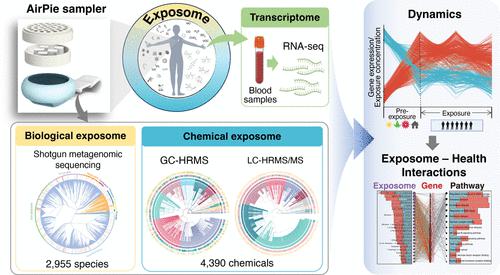当前位置:
X-MOL 学术
›
Environ. Sci. Technol.
›
论文详情
Our official English website, www.x-mol.net, welcomes your feedback! (Note: you will need to create a separate account there.)
Longitudinal Mapping of Personal Biotic and Abiotic Exposomes and Transcriptome in Underwater Confined Space Using Wearable Passive Samplers
Environmental Science & Technology ( IF 11.4 ) Pub Date : 2024-03-11 , DOI: 10.1021/acs.est.3c09379 Zinuo Huang 1, 2, 3 , Chen Peng 1, 2 , Zixin Rong 1 , Liuyiqi Jiang 1, 2 , Yueer Li 1, 2 , Yue Feng 4 , Shuanghong Chen 5 , Changyong Xie 5 , Chao Jiang 1, 2, 3
Environmental Science & Technology ( IF 11.4 ) Pub Date : 2024-03-11 , DOI: 10.1021/acs.est.3c09379 Zinuo Huang 1, 2, 3 , Chen Peng 1, 2 , Zixin Rong 1 , Liuyiqi Jiang 1, 2 , Yueer Li 1, 2 , Yue Feng 4 , Shuanghong Chen 5 , Changyong Xie 5 , Chao Jiang 1, 2, 3
Affiliation

|
Silicone-based passive samplers, commonly paired with gas chromatography–mass spectrometry (GC-MS) analysis, are increasingly utilized for personal exposure assessments. However, its compatibility with the biotic exposome remains underexplored. In this study, we introduce the wearable silicone-based AirPie passive sampler, coupled with nontargeted liquid chromatography with high-resolution tandem mass spectrometry (LC-HRMS/MS), GC-HRMS, and metagenomic shotgun sequencing methods, offering a comprehensive view of personalized airborne biotic and abiotic exposomes. We applied the AirPie samplers to 19 participants in a unique deep underwater confined environment, annotating 4,390 chemical and 2,955 microbial exposures, integrated with corresponding transcriptomic data. We observed significant shifts in environmental exposure and gene expression upon entering this unique environment. We noted increased exposure to pollutants, such as benzenoids, polycyclic aromatic hydrocarbons (PAHs), opportunistic pathogens, and associated antibiotic-resistance genes (ARGs). Transcriptomic analyses revealed the activation of neurodegenerative disease-related pathways, mostly related to chemical exposure, and the repression of immune-related pathways, linked to both biological and chemical exposures. In summary, we provided a comprehensive, longitudinal exposome map of the unique environment and underscored the intricate linkages between external exposures and human health. We believe that the AirPie sampler and associated analytical methods will have broad applications in exposome and precision medicine.
中文翻译:

使用可穿戴被动采样器对水下密闭空间中的个人生物和非生物暴露体和转录组进行纵向测绘
基于有机硅的被动采样器通常与气相色谱-质谱 (GC-MS) 分析配合使用,越来越多地用于个人暴露评估。然而,其与生物暴露组的相容性仍有待探索。在这项研究中,我们介绍了基于硅胶的可穿戴 AirPie 被动采样器,结合非靶向液相色谱与高分辨率串联质谱 (LC-HRMS/MS)、GC-HRMS 和宏基因组鸟枪测序方法,提供了全面的视图个性化空气传播的生物和非生物暴露组。我们将 AirPie 采样器应用于独特的深水下受限环境中的 19 名参与者,注释了 4,390 种化学品和 2,955 种微生物暴露,并与相应的转录组数据集成。我们观察到进入这种独特环境后环境暴露和基因表达发生了显着变化。我们注意到污染物的暴露量增加,例如苯类化合物、多环芳烃 (PAH)、机会性病原体和相关的抗生素抗性基因 (ARG)。转录组分析揭示了神经退行性疾病相关途径的激活(主要与化学暴露有关)以及免疫相关途径的抑制(与生物和化学暴露有关)。总之,我们提供了独特环境的全面、纵向暴露图,并强调了外部暴露与人类健康之间的复杂联系。我们相信 AirPie 采样器和相关分析方法将在暴露组和精准医学领域具有广泛的应用。
更新日期:2024-03-11
中文翻译:

使用可穿戴被动采样器对水下密闭空间中的个人生物和非生物暴露体和转录组进行纵向测绘
基于有机硅的被动采样器通常与气相色谱-质谱 (GC-MS) 分析配合使用,越来越多地用于个人暴露评估。然而,其与生物暴露组的相容性仍有待探索。在这项研究中,我们介绍了基于硅胶的可穿戴 AirPie 被动采样器,结合非靶向液相色谱与高分辨率串联质谱 (LC-HRMS/MS)、GC-HRMS 和宏基因组鸟枪测序方法,提供了全面的视图个性化空气传播的生物和非生物暴露组。我们将 AirPie 采样器应用于独特的深水下受限环境中的 19 名参与者,注释了 4,390 种化学品和 2,955 种微生物暴露,并与相应的转录组数据集成。我们观察到进入这种独特环境后环境暴露和基因表达发生了显着变化。我们注意到污染物的暴露量增加,例如苯类化合物、多环芳烃 (PAH)、机会性病原体和相关的抗生素抗性基因 (ARG)。转录组分析揭示了神经退行性疾病相关途径的激活(主要与化学暴露有关)以及免疫相关途径的抑制(与生物和化学暴露有关)。总之,我们提供了独特环境的全面、纵向暴露图,并强调了外部暴露与人类健康之间的复杂联系。我们相信 AirPie 采样器和相关分析方法将在暴露组和精准医学领域具有广泛的应用。



























 京公网安备 11010802027423号
京公网安备 11010802027423号